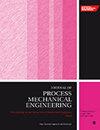Prediction of performance parameters of a hermetic reciprocating compressor under different discharge lift limiter heights by machine learning
IF 2.2
4区 工程技术
Q2 ENGINEERING, MECHANICAL
Proceedings of the Institution of Mechanical Engineers, Part E: Journal of Process Mechanical Engineering
Pub Date : 2024-05-06
DOI:10.1177/09544089241249854
引用次数: 0
Abstract
The research examines the complex correlation between discharge valve properties in severe temperature circumstances, ranging from 54.4°C to −23.3°C, in accordance with ASHRAE operational guidelines. The design parameters include examining valve thicknesses of 0.127, 0.152, 0.178, and 0.2 mm, together with lengths of 14.722, 16.222, and 17.722 mm, at compressor speeds of 1300, 2100, and 3000 rpm. An artificial neural network (ANN) is used to replicate the output properties of a hermetic reciprocating compressor, which include the ratio of cooling capacity to compression power and volumetric efficiency. One hundred and eleven numerically recorded datasets are used to train the developed ANN model. The model is trained using 77 datasets, validated using 17 datasets, and tested using 17 datasets. The LM-type ANN approach is used to train the multilayer perception neural network, which consists of a hidden layer with 15 neurons. Given the proximity of the margin of deviations (MoDs) to the 0% deviation line, the variances between the ANN and fluid-structure interaction outcomes for the cooling capacity to compression power ratio and volumetric efficiency are insignificant. The average figures for the MoD output have been calculated as −0.18% and 0.06, respectively. Not only do the data points lie on the line, indicating a 0% error, but they also fall inside the interval, indicating a 10% error. In addition, the mean squared error and correlation coefficient values for the ANN model that was created are 2.04E-03 and 0.99853, respectively.通过机器学习预测不同排气升程限制器高度下全封闭活塞式压缩机的性能参数
该研究根据 ASHRAE 操作指南,考察了在从 54.4°C 到 -23.3°C 的恶劣温度条件下排放阀性能之间的复杂关联。设计参数包括在压缩机转速为 1300、2100 和 3000 转/分钟时,检查 0.127、0.152、0.178 和 0.2 毫米的阀门厚度,以及 14.722、16.222 和 17.722 毫米的长度。人工神经网络(ANN)用于复制全封闭往复式压缩机的输出特性,包括冷却能力与压缩功率的比率和容积效率。开发的 ANN 模型使用了 111 个数字记录数据集进行训练。该模型使用 77 个数据集进行训练,使用 17 个数据集进行验证,并使用 17 个数据集进行测试。多层感知神经网络采用 LM 型 ANN 方法进行训练,该网络由一个包含 15 个神经元的隐藏层组成。由于偏差裕度(MoDs)接近 0% 偏差线,因此在冷却能力与压缩功率比和容积效率方面,ANN 和流体与结构相互作用结果之间的差异并不明显。经计算,MoD 输出的平均值分别为 -0.18% 和 0.06。数据点不仅位于直线上,表明误差为 0%,而且位于区间内,表明误差为 10%。此外,所创建的 ANN 模型的均方误差和相关系数值分别为 2.04E-03 和 0.99853。
本文章由计算机程序翻译,如有差异,请以英文原文为准。
求助全文
约1分钟内获得全文
求助全文
来源期刊
CiteScore
3.80
自引率
16.70%
发文量
370
审稿时长
6 months
期刊介绍:
The Journal of Process Mechanical Engineering publishes high-quality, peer-reviewed papers covering a broad area of mechanical engineering activities associated with the design and operation of process equipment.

 求助内容:
求助内容: 应助结果提醒方式:
应助结果提醒方式:


